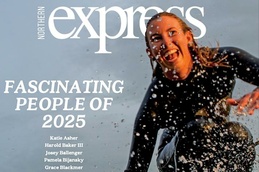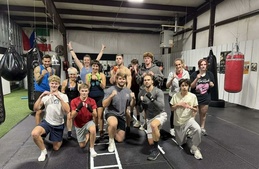
Fun with Fiber
From weaving to costume design, textile artists share their stories
By Ross Boissoneau | Nov. 26, 2022
Visual artists work in a variety of media: oils, watercolors, pastels, charcoal. Bronze, clay, stone. But let’s not forget textiles, because Abigail Deloria and Mica Harrison certainly won’t. The two share a fondness for turning materials into art, though their methods and results differ greatly.
The Weaver
Start with Deloria, who works from her farm in Pellston. An accomplished weaver and knitter, she says she first came to the notion of working with fabrics as a youngster. “I loved to sew as a really little girl. My mom taught me how to knit. As the years went by, I wanted to learn how to weave,” she says.
Consider that box checked. Since giving in to the addiction (her word) in college, Deloria has produced dishtowels, scarves, blankets, and more in a dizzying array of colors and patterns. And while she adopted the practice in her late teens, fiber work dates back thousands of years. “It’s an ancient craft,” she says, and she’s right—it’s mentioned in Greek mythology and biblical texts.
Despite its age, weaving seems to be having a bit of a renaissance. “A lot of people think of it as a lost art,” Deloria admits, but she sees it otherwise. One reason is that those who are into weaving are enthusiastic about bringing others into the fold. “Weavers are willing to share their knowledge,” she says.
Today, Deloria boasts a myriad of equipment, with looms of various shapes, sizes, and manufacturers. Weaving and its cousin spinning—yes, she does that too—use terms so foreign to the uninitiated as to be in a different language: sheds, warp, weft, thrum, shuttle, heddle.
Whatever the terminology, Deloria uses her tools to create everything from small dish towels to large blankets. “Usually it’s scarves, table runners, and towels,” Deloria says of the products she produces. While their use may be ordinary, their appearance is anything but. The patterns and vibrant colors make stunning art of the everyday items.
In addition to her own work, she helped found the Top of the Mitt Fiber Fair. She and a group of similarly inclined artisans put together the annual event, held the first weekend in June, where they showcase everything from their various creations to the fibers they use to the sheep and alpaca where the fibers originate. “We want … the community to see weaving and spinning and the animals onsite,” she says.
Deloria considers herself a “production weaver” and sells her products at farm markets and online. While weaving and spinning feed her artistic soul, she works full time for the natural food store Grain Train in Petoskey. She and her husband Phil also own and run the organic operation Fiddlehead Farm in Pellston. Her responsibilities for the latter include staffing the Fidddlehead stand at the Harbor Springs Farm Market, where they sell both produce and Abbie’s colorful wares.
That means during the store’s busy season and the farm market season, she is often too busy to create her fiber art. It’s mainly a wintertime activity. “In the summer, I just don’t have the time. In fall and winter when the market ends, I have more time to weave,” she says.
Learn more at fiddlehead.net/adeloria.
The Costumer
For Mica Harrison, the timing is almost the opposite. That’s because her day job takes over her time from fall through spring, leaving her summertime to pursue her love of fiber art.
“I’m the director of recruiting for undergraduate programs at Carnegie Mellon University’s Office of Admission,” she says. “I just moved from drama admissions to the central office.” Harrison spends summers in Traverse City and the rest of the year in Pittsburgh, home of Carnegie Mellon.
She came to the notion of textile art from a different discipline. “I’ve been doing art since I could walk,” she says. “My original plans were to go [to college] for photography. I loved that, but when I took one fiber class I said, ‘That’s it. I’m switching.’”
As a result, she’s now both a fiber artist and a photographer. Oh, and as a theater buff as well (more on that momentarily). Her fiber art incorporates color, design, and pattern into wall hangings, wearable art such as scarves, and even quilts. “I’m informed by northern Michigan,” she says, from the people to the colors.
She frequently enhances the cloth, yarn, and other textiles with everything from sticks and stones to seashells and barnacles. “I’m in love with found objects,” Harrison admits.
Then there’s that theater connection. Harrison is an accomplished costumer, and has worked with Parallel 45 Theatre, Interlochen Shakespeare Festival, IU Summer Theatre (previously Indiana University Festival Theatre), and Cardinal Stage Company. She’s also worked on commission with a permanent exhibition at Farm Bloomington and costumes for Winged Messenger, a music and dance production at Western Michigan University.
“I spent a summer with the IU Festival Theatre and loved it. One of the fun things in costuming and fibers is how flexible they are,” she says, comparing that to sculptors who work in stone or metal. “Then I interned with the Interlochen costume shop and the Shakespeare Festival. It was so much fun.”
Her work with Parallel 45 has included shows like A Christmas Carol and Medea. Harrison says for the latter she worked with the director to shape the costume in layers and colors that would complement the production.
In conversation it’s obvious that one of the things that excites her about costuming is the freedom to use many different materials. “Canvas, wool roving, beads, stretched linen. I look at layering [materials] like layering of characters.”
Harrison is also member of the Environmental Voter Project; a Green Artist, supporting organizations that tackle environmental justice and the intersectionality of racism and climate change; and a member of Beyond Artists, a coalition of artists who donates a percentage of their project fees to organizations they care about.
Her approach to all her art, no matter the medium, is perhaps best exemplified by a teaching from one of her instructors. “A professor said, ‘Give the viewer the opportunity to engage at many levels.’ That has really stuck with me.”
Learn more at micamharrison.com.
Trending

Building the Life You Want
Who needs a life coach? While people seek out life coaches for a variety of reasons, one theme is almost always present, co… Read More >>
Nominations are Open for Fascinating People 2026!
That’s right folks, it’s time to think about the most wonderful, curious, eclectic, fantastic, and fascinating p… Read More >>
Winter Trails Day 2025
Celebrated throughout the North, Winter Trails Day invites kids and grown-ups alike to discover the fun of trail-based snows… Read More >>


